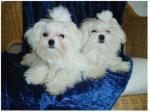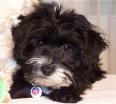
The Maltese Breed
Overview of the breed.
Maltese are excellent companion dogs. When treated well they rarely develop bad habits of biting or scratching. They're patient with children as long as the child isn't very rough with the dog. They have a tendency to bond strongly with one person, but can still be affectionate to other members in the family. As with all animals they each have a personality all their own, which will develop and mature when loved cared for.
What to look for in a puppy.
Once you decide that the maltese breed fits your lifestyle and personality, there are some thing you should look at when you're selecting a puppy.
First off see what kind of place it's coming from. Did the breeder take good care of the dogs, did they spend time with them, or is it strictly a money-making venture to them? A well-socialized puppy will make a better adult dog than one who was simply left in a kennel somewhere.
Observe the puppies as a litter for a few minutes before you single one out. Is it active and playful? Some puppies are shy when you pick them up at first, so you can't judge very well how active it is once you handle it.
Look at the eyes of the dog. They should be black, and rimmed in black. Always check for any sores on the dogs eyes, because they can be signs of worse health problems.
Next, the coat. Is it pure white? A lot of dogs have lemon spots, which is acceptable, but anything other than lemon, or off-white markings, is not (the face will have tear-stains, this is virtually unavoidable with most dogs). It's hair also be straight and thick.
If you plan to breed the dog, then you may want to check the paw-pads to see if they're black as well. It's not a fault to have pink paw-pads but black is more desirable. Also, the nose should be pure black. Again, if you just want a companion dog, a little bit of pink on the nose won't hurt you.
Neck: Sufficient length of neck is desirable as promoting a high carriage of the head.
Body: Compact, the height from the withers to the ground equaling the length from the withers to the root of the tail. Shoulder blades are sloping, the elbows well knit and held close to the body. The back is level in topline, the ribs well sprung. The chest is fairly deep, the loins taut, strong, and just slightly tucked up underneath.
Tail: A long-haired plume carried gracefully over the back, its tip lying to the side over the quarter.
Legs and Feet: Legs are fine-boned and nicely feathered. Forelegs are straight, their pastern joints well knit and devoid of appreciable bend. Hind legs are strong and moderately angulated at stifles and hocks. The feet are small and round, with toe pads black. Scraggly hairs on the feet may be trimmed to give a neater appearance.
Coat and Color: The coat is single, that is, without undercoat. It hangs long, flat and silky over the sides of the body almost, if not quite, to the ground. The long head-hair may be tied up in a topknot or it may be left hanging. Any suggestion of kinkiness, curliness, or wooly texture is objectionable. Color, pure white. Light tan or lemon on the ears is permissible but not desirable.
Size: Weight under 7 pounds, with from 4 to 6 pounds preferred. Overall quality is to be favored over size.
Gait: The Maltese moves with a jaunty, smooth, flowing gait. Viewed from the side, he gives an impression of rapid movement, size considered. In the stride, the forelegs reach straight and free from the shoulders, with elbows close. Hind legs to move in a straight line. Cowhocks or any suggestion of hind leg toeing in or out are faults.
Temperament: For all his diminutive size, the Maltese seems to be without fear. His trust and affectionate responsiveness are very appealing. He is among the gentlest mannered of all little dogs, yet he is lively and playful as well as vigorous.
Basic Care
Feeding
A transition from one home to another is one of the most important times to maintain consistent diet. For the first few weeks stay with the diet the breeder had him on. After that it can be adjusted, slowly, to what you think is best.
Because maltese are such a small breed, puppies and adults alike will have trouble chewing large-bite, or even medium-bite food. Several brands have a small-breed formula, Eukanuba is the one I use.
For puppies a small-breed puppy formula should always be used. For puppies just starting to eat dry food, it's advisable to soak the food in hot water before you feed it to them. For especially picky dogs or those with bad bites that make chewing more diffucult you may want to soak the food as well.
Usually a good-quality dog food for small breeds will have the right amounts of protein, carbohydrates, fat and vitamins, but if you aren't sure check with your vet.
Of course, water should be readily available at all times, especially in hot weather.
Housing
I do not recommend leaving maltese outside at night. They're prone to cold and generally do not like being confined away from the family. Inside, they're fine to sleep on a blanket on the floor, a small dog bed, etc. Dixie, one of our females, loves to sleep on a pillow on the floor or at the foot of my bed.
Grooming
One of the most recognizable traits of the maltese, is the long, beautiful coat. Everyone has their own tricks-of-the-trade for grooming, but some of the most common and helpful grooming tools are a small or medium size slicker brush, a wide-tooth comb, and an uneven comb. There are a variety of shampoos on the market, a gentle shampoo for white coats will do fine for everything but the face. For the face a tear-free cleanser is best.
Grooming should begin with puppies, to get them used to being brushed and combed. Even so some dogs are just not going to like it. For the more difficult of these a small grooming table could be a good investment.
Toenails should be clipped once a month, front and back. This is another thing a lot of dogs don't like but there's no way around it. Getting a second person to help you will make it easier. For extra-long nails, clipping them once to a little above the quick, then a few days later repeating will help you not to cut painfully close to the quick, because it recedes somewhat.
A lot of maltese are prone to ear infections. These can be prevented by cleaning out the ears regularly and pulling out any hair that grows in them. If you see your dog scratching around its ears a lot, or cries or bites when you touch his ears take him to a vet. Ear infections are easily treatable.
Maltese Dogs
Breed standard for adult dogs.
As defined by the American Kennel Club, this is the breed standard for Maltese.
Head: Of medium length and in proportion to the size of the dog. The skull is slightly rounded on top, the stop moderate. The drop ears are rather low set and heavily feathered with long hair that hangs close to the head. Eyes are set not too far apart; they are very dark and round, their black rims enhancing the gentle yet alert expression. The muzzle is of medium length, fine and tapered but not snipy. The nose is black. The teeth meet in an even edge-to-edge bite, or in a scissor bite.
 |
 |
|
 |
 |
 |
 |
 |
 |
Ear Hematomas
An ear hematomas is a firm fluid-filled swollen mass that is visible on the inside of the earflap. Usually the dog will get an ear hematomas from shakng its head or scratching its ear because it has an underlying allergy or ear disease. The scratching or shaking of the ear ruptuers the tiny blood vessels in the ear's cartilage causing them to bleed under the skin of the earflap forming a pocket of blood. Occasionally the ermatomas is caused by a dog fight where the fight has caused ruture of the blood vessels. Others causes include an infection or inflamation of the ear, the precence of a forgeign body or ear parasite. These all cause pain, itchiness or irritation that a dog would seek to allec\viate by shaking or scratching. There are several procedures for treating aural hematomas the approach will depend on the severity of the dogs condition. One method involves the placing of a drain securely into thr tip of the ear allowing the fluid to drain. This is left in place for 2-3 weks as the ear flap seals. Another method performed under general anaesthesia involves making a surgical incision into the swelling on the ear allowing the fluid to drain. Then multiple sutures are stitched into the ear to seal it back together. After about 7-10 days following the procedure after the ear has drained and healed fully the sutures will be removed. Failure to treat a hematomas can lead to enlargement of theswelling to encompass the entire ear flap. Also scars tissue formation within the hematomas will result in a severly wrinkled thickened black earflap that will predispose the dog to further ear problems. To help prevent ear hematomas formation it is essential that we determine what is causing the irriation that is making the dog shake its head or scratch its ears. A thorough examination of the ear will be necessary. When the dog is brought to the clinic we may use an otoscopes to look down into the ear canals to determine the presence of a forgeign body or inflamation in the ears. Ear swabs often are taken and the material is evaluated under the microscope to look for causes of otitis such as yeast ear mite or bacterias. Allergies also cause irriation to the ears. Wound of the pinna or earflap should be treated to prevent traumato the ear caused by shaking and scratching.